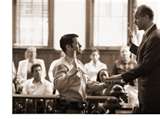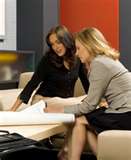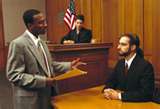During witness preparation, what you hear from a witness in an attorney’s office may be worlds apart from what you hear from that witness on the stand. The environment in which witnesses are questioned has a profound impact on their behavior, demeanor and testimony. A lawyer’s office or conference room provides a very different set of stimuli from a realistic courtroom environment. As a result, what witnesses say and how they act can differ vastly based on where testimony is elicited.
This article explores how the environment where a witness is prepared affects testimony’s substance and style. Transitioning between a conference room and a courtroom setting can have a dramatic impact on what witnesses say and how they say it. While many lawyers may conduct witness preparation in settings that fall somewhere in between these two extremes, the way witnesses respond to the transition provides valuable insights into preparing witnesses.
Conference Room versus Courtroom: Two Very Different Settings
The most basic goal of witness preparation is familiarization: witnesses learn what kinds of questions may be asked, attorneys learn about the facts of the case as their witnesses see them, and each learns some basic information about the other’s style of asking or answering questions. Witness preparation is commonly conducted in a conference room or office. These tend to be smaller, less imposing spaces than courtrooms and the tone of preparation is generally more casual. The lawyer is usually seated, and all parties tend to be somewhat more relaxed and comfortable than in court.
At the other end of the spectrum are exercises that take place in a mock courtroom, which is designed to duplicate the atmosphere of an actual courtroom. This familiarizes witnesses with the trial process by immersing them in an experience that looks and feels as much like “the real thing” as possible. One of the primary advantages of using this setting is to expose witnesses to the various stresses of the courtroom and the unfamiliarity of the environment – making for a very different experience from in-office preparation.
What Can We Learn from Each Environment?
The Conference Room
Preparation that is conducted in the lawyer’s office or conference room can generally be considered an open-ended process. Parties are free to stop and start questioning, revisit or rephrase questions and answers, and become acquainted with each other’s styles and personalities.
Preparing witnesses in the conference room allows the attorney to see a more natural side of witnesses and gain insight into personality and demeanor. It makes the exercise feel less like an examination and more like a conversation, often encouraging the witness to explain “what really happened” in a narrative form. Everyone present may ask questions, take risks and share information to develop case themes, strengthen existing arguments and defuse counterclaims.
In contrast to the courtroom setting, in an office or conference room witnesses are more likely to be relaxed and, therefore:
• Give longer and more in-depth responses
• Use layperson’s terms and colloquialisms
• Use analogies and more expressive language
It is much easier to gain insight into the natural personality and demeanor of the witness in the office. It is also much easier to address issues with testimony, such as gaps in the story or witness discomfort, on the spot. If any part of the testimony does not pass the “sniff test” – perhaps because the witness is making assumptions or leaving out important facts – those involved in the preparation are free to backtrack and get clarification.
In the office or conference room, it is possible to put the witness at ease by, for example, prefacing a question with the phrase “off the record.” These three words transform the dynamic of the room, and equate to a “commercial break” in witnesses’ minds. This alleviates much of the pressure to perform and helps witnesses let their guard down, leading to more effective and authentic responses.
Unfortunately, the primary advantage of the office setting is also its main drawback. For most people, courtrooms are unfamiliar and intimidating theaters where they feel judged – and, in fact, they are. As a result of the stress, a witness who was sitting across from us at the conference table can suddenly transform into someone else when thrown into the theater of the courtroom, with correspondingly dramatic alterations in the substance and style of testimony.
 The Courtroom Simulation
The Courtroom Simulation
By exposing witnesses to a setting and experience that looks and feels like the “real thing,” the attorney or trial consultant can begin familiarizing them with what lies ahead. This witness orientation is an important and frequently overlooked part of witness preparation.
Simulating the courtroom environment provides an opportunity to inoculate witnesses against myriad factors that can cause anxiety, including seemingly insignificant details, such as the layout of the courtroom, which can significantly impact the quality of the testimony. Imagine if you were cast as the lead of a play but never saw the stage until opening night. Not knowing what the set looks like, size of the theater or audience capacity would, understandably, impact the quality of performance. Even seasoned actors would balk if asked to perform under such conditions, yet this is what lawyers frequently require of their witnesses.
While this comparison is not intended to suggest that testifying in court is like spouting out lines in a play, it is intended to convey the impact testifying in an unfamiliar environment can have. The physical courtroom layout can affect even the most basic aspects of the experience, such as the witness’s ability to see and hear. In addition, a courtroom-like setting can help witnesses get acquainted with the feeling of testifying at a distance from the attorneys or the judge, and learn the ins and outs of interacting with trial demonstratives. The more witness preparation can reproduce and familiarize witnesses with these factors, the more witnesses feel in control at trial.
At the same time, one of the most important reasons to bring witnesses into a simulated courtroom setting is to make them uncomfortable. Witnesses who are prepared in an attorney’s office eventually become acclimated to their surroundings. They may come to think that they and their attorneys have more control over the proceedings than they actually do. Indeed, this is one of the main dangers of using an office or conference room setting, where either party feels free to interrupt the flow of questioning to backtrack, clarify or regroup.
When plunged into the surroundings of the courtroom, the comfort level of the witness is dramatically reduced. The witness must get used to being in unfamiliar territory in the presence of unfamiliar people. This can initially provoke anxiety, but the benefits of duplicating the discomfort witnesses can experience in a courtroom before trial is immensely valuable in getting them ready for what lies ahead. Perhaps the most beneficial aspect of duplicating the courtroom atmosphere is to provide lawyers insight into what they can actually expect from their witness at trial, as well as a chance to address behavior that undermines credibility.
Upon entering the mock courtroom, a witness’s responses range from somewhat to extremely different from what they were in the office. In this setting, witnesses tend to:
• Use more formal language, technical terms and “legalese”
• Be either more or less responsive to questions, answering tersely or providing too much information
• Engage in more “role playing”
• Exhibit fears of public speaking or speaking in front of an authority figure
We have observed dramatic changes in witnesses’ demeanor during preparation sessions. For example, a likeable company president who cracked jokes in conference room sessions became deadly serious in our mock courtroom, and dropped much of the expressiveness from his conference room language. Moreover, he made statements that the trial team never heard in the conference room.
 After repeated witness preparation sessions, it was apparent that the witness, who was a former FBI agent, believed he had to play a role in the courtroom, before the authority figure of a judge, that he did not play in the conference room. In the mock courtroom, he adopted a “just the facts, ma’am” demeanor, used rigid language and appeared defensive, all of which impeded his ability to tell his story or convey likeable or sympathetic characteristics. It was only by observing him closely as he transitioned between the two settings that we were able to make recommendations that allowed him to reinstate normal language back into his testimony – and eliminate the undesirable persona of “The FBI Agent” from his courtroom demeanor.
After repeated witness preparation sessions, it was apparent that the witness, who was a former FBI agent, believed he had to play a role in the courtroom, before the authority figure of a judge, that he did not play in the conference room. In the mock courtroom, he adopted a “just the facts, ma’am” demeanor, used rigid language and appeared defensive, all of which impeded his ability to tell his story or convey likeable or sympathetic characteristics. It was only by observing him closely as he transitioned between the two settings that we were able to make recommendations that allowed him to reinstate normal language back into his testimony – and eliminate the undesirable persona of “The FBI Agent” from his courtroom demeanor.
Witnesses often diminish their authenticity by assigning themselves such a character or role to play in the courtroom. Other roles we have seen emerge in the courtroom setting are “The Expert” who speaks with authority on every topic, and “the CEO” who feels responsible for overseeing every business transaction. But, because authenticity is the cornerstone to credibility, witnesses who embrace their more relaxed, conference room personality on the stand, rather than role-playing, are generally more likeable and credible. Since it is only possible to eliminate such undesirable behavior if you know about it, duplicating at least some of the important aspects of the courtroom environment can be very helpful preparing your witness – and yourself.
10 Ways to Bring the Courtroom into the Conference Room
In many cases, gaining access to a mock courtroom is not feasible. There are, however, other ways you can reproduce important aspects of the courtroom. Below are ten suggestions to help you change your office environment to enable you get a better sense of how witnesses may react in court.
1. Vary settings
After you have questioned your witness in one location for a few sessions and feel the witness is ready, change your environment to some other room or office to test how the witness will behave in territory that is unfamiliar.
2. Create distance
Changing the distance between you and your witness can have almost as great an impact on testimony as changing the location. Some people have a dramatic response to changes in distance during questioning, dropping or raising their voices and experiencing significantly more or less anxiety depending on how far they are from other speakers and listeners.
3. Incorporate anticipated techniques
Learn as much as possible about the personality, demeanor of the judge and opposing counsel. Does the judge like to interrupt and ask questions? Is he or she completely silent and hands-off throughout the trial? Is opposing counsel especially aggressive? Does he or she lure witnesses into saying too much by creating a false sense of security or allowing silence to hang? Remember, the more you and your witness know in advance, the better you both will be able to respond at trial.
4. Enlist others
It is invariably a good idea to get your witness used to being questioned by someone other than yourself. Make sure to observe both desirable and undesirable changes in your witness in response to other questioners.
 5. Alter language
5. Alter language
Witnesses tend to respond differently to different language styles. For example, a witness almost instinctively copies or “mirrors” the pace of the questioner. If the lawyer speaks quickly, the witness will speak quickly; if she is high-energy, he is high-energy; if she is calm, he is calm. Teach your witness techniques such as consciously slowing down, pausing, and asking for the question to be repeated to regain control of the line of questioning. It is helpful for witnesses to keep in mind that the lawyer cannot ask the next question until the current question is answered. Witnesses should know that they can control the courtroom and can usurp the power from opposing counsel by simply using silence.
6. Include audience
Whether your witness is being prepared for a bench or jury trial, he or she will be testifying in front of several people. Bring in a small audience of people to observe at a witness preparation session. Since it is a truism that people are more afraid of public speaking than of death, pay close attention to how the witness reacts when testifying in front of an audience and be ready to help with some stress-reduction tactics.
7. Replicate courtroom
Go to the courthouse in advance and note how the room is set up. Find out where the judge, the jury and opposing counsel will be located and duplicate as many of these conditions as possible to familiarize the witness with the layout of the courtroom.
8. Do a dry run
Question the witness for at least an hour at a time without interruption in order to assess how the witness reacts as he or she begins to tire, and how this impacts trial strategy. Do not take any breaks or allow yourself or your witness to backtrack or ask questions.
9. Interact with visuals
Effectively interacting with graphics takes practice. Make sure the witness is comfortable with demonstratives and is prepared to explain them when necessary. Exhibits are meant to help the witness teach the jury but are ineffective if the witness is unfamiliar or uneasy with the material. The witness should know exactly which demonstratives will be used, and when, in order to seamlessly interact with them.
10. Positively reinforce & empower
In the field of witness preparation, we are always thinking about how to construct new situations to put witnesses to the test. If you take the initiative to record, remember and reinforce the positive aspects of your witness’s performance as you alternate between the conference room and the courtroom, you can help increase the confidence and comfort level that make for truly effective testimony.
Conclusion
The physical setting where a witness is prepared can have a dramatic effect on the content and delivery of testimony. Though it is not always feasible to gain access to a mock courtroom for witness preparation, it is possible for a creative attorney or trial consultant to duplicate some important aspects of the courtroom in the office, and observe how this affects the witness. The more witnesses know what to expect on the day of trial, the better job they can do, and the more you know what to expect from your witnesses, the better job you can do when you your side makes the transition from the conference room to the actual courtroom.
References
Futterman, R. (2008). Advanced Witness Preparation Using Psychological Techniques. In Solomon, S. H., Gallant, J., Esser, J. P. (Eds.). The Science of Courtroom Litigation: Jury Research and Analytical Graphics, New York: ALM Publishing.
Posey, Amy J., & Wrightsman, Lawrence S. (2005). Trial Consulting. New York: Oxford University Press.
Waites, R. D. (2003). Courtroom Psychology and Trial Advocacy. New York: ALM Publishing.
Valerie Blum is a Trial Consultant in New York City. She applies her background as a lawyer, writer and designer to shape effective case narrative and visual strategies for her clients. Her focus is predominantly on civil and white collar criminal matters. You can contact her at [email protected].
Alexandra Rudolph is an experienced Trial Consultant with DOAR Litigation Consulting in New York City who has consulted on hundreds of cases across the USA and in the United Kingdom. Alexandra uses her insight into juror decision-making to develop winning trial strategies by increasing credibility of key witnesses and crafting a compelling case story. Her practice areas include: mock trials, jury selection, shadow juries and post-trial interviews although she specializes in witness preparation for experts, executives and lay witnesses. She is frequently invited to serve as faculty for CLE programs, speak at national conventions and is an active member of ASTC. Contact her at [email protected].
Citation for this article: The Jury Expert, 2009, 21(4), 45-50.
This is a wonderful piece that I was happy to discover! Guiding the witness from the user-friendly venue to the more daunting "theater" of the courtroom is an ongoing challenge that requires the empathy and steps that are described so clearly here. Thanks for a great article!
Good article. I would especially like to emphasize Tip #7 – Go to the courtroom. I try to make it a practice to take my clients to the courtroom before all trials so they are familiar with the setting. Many have commented to me that this small act made them feel more at ease when it came time to testify. They have enough to think about when they testify and do not need to also worry about the new and unfamiliar setting.